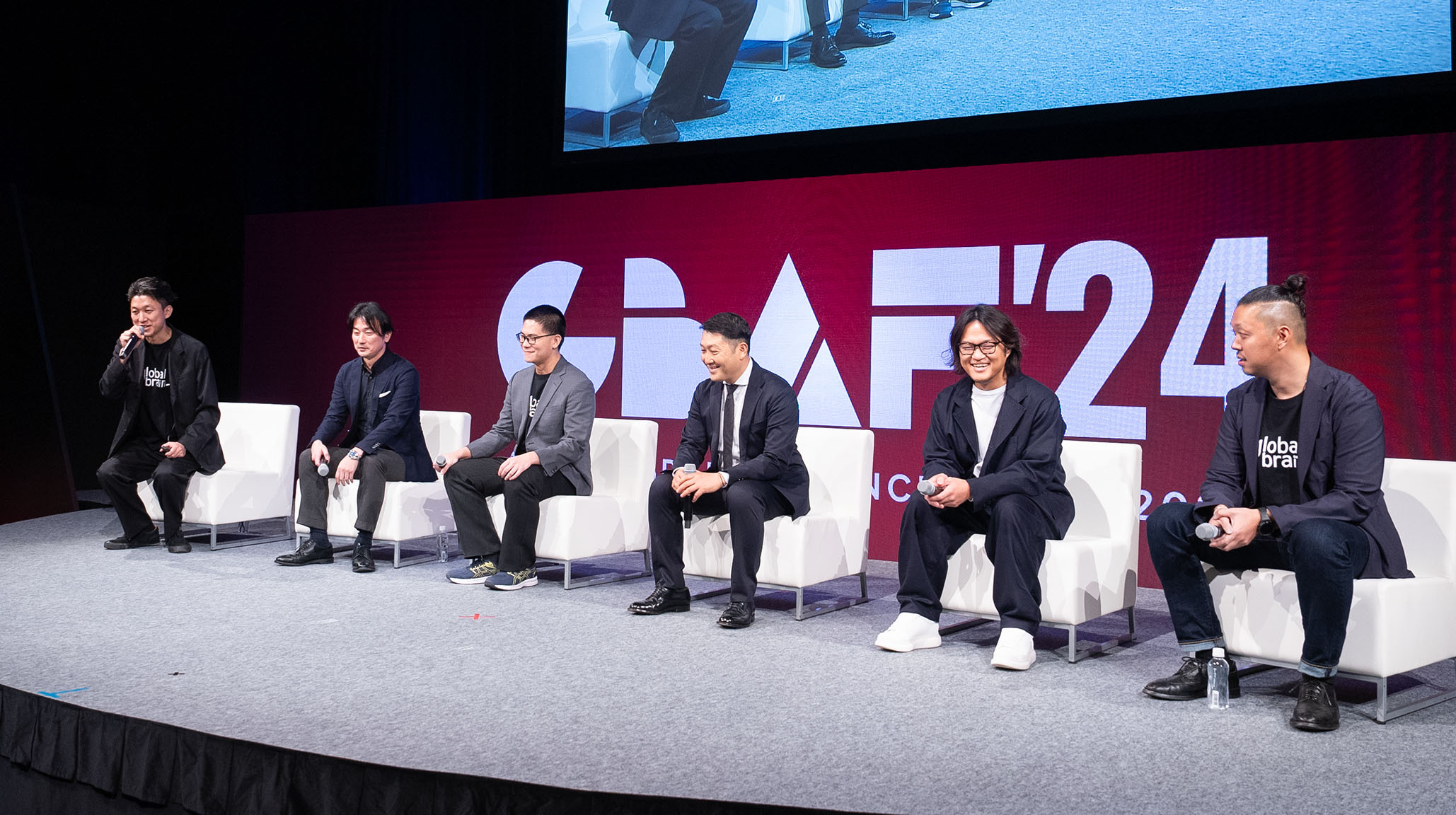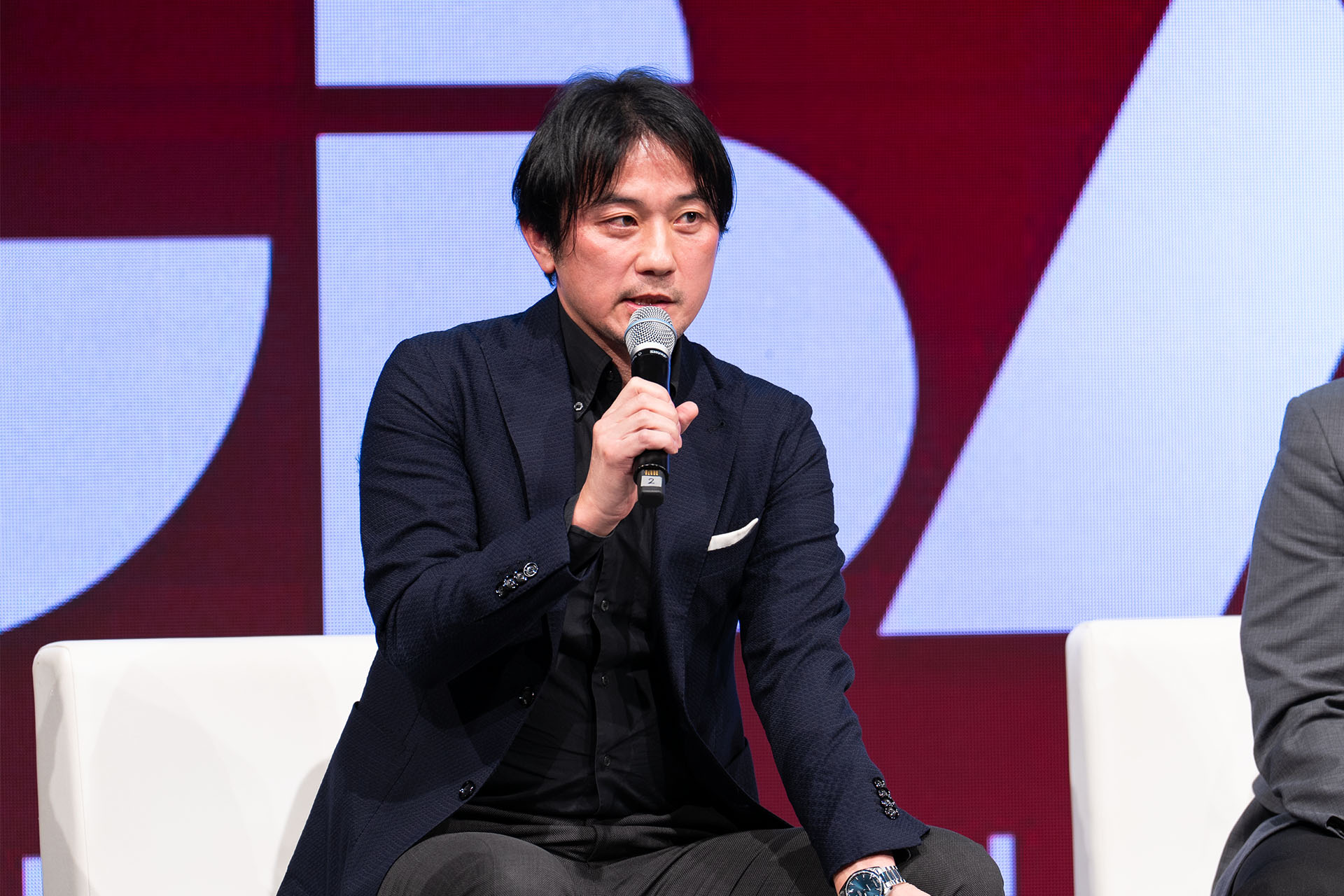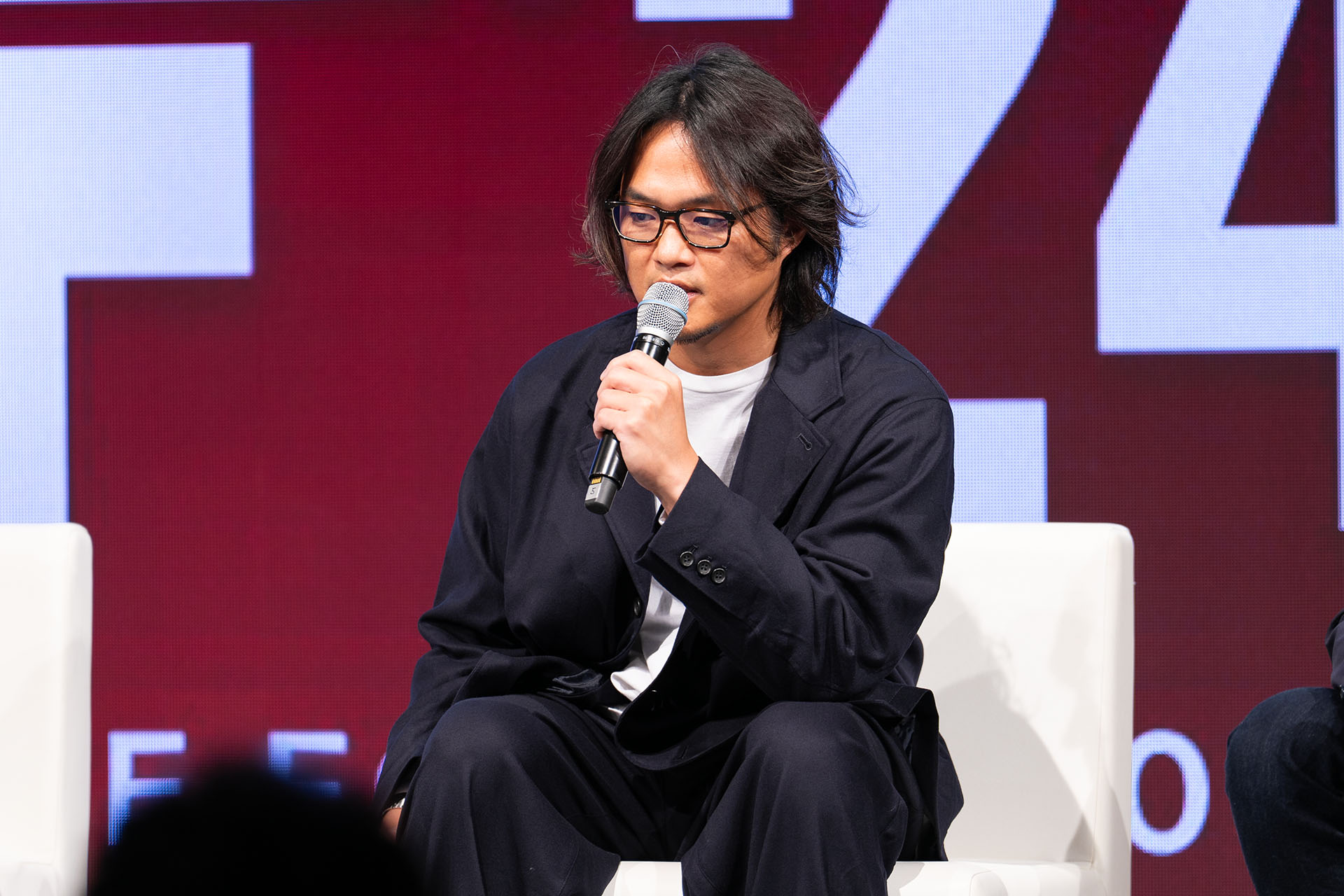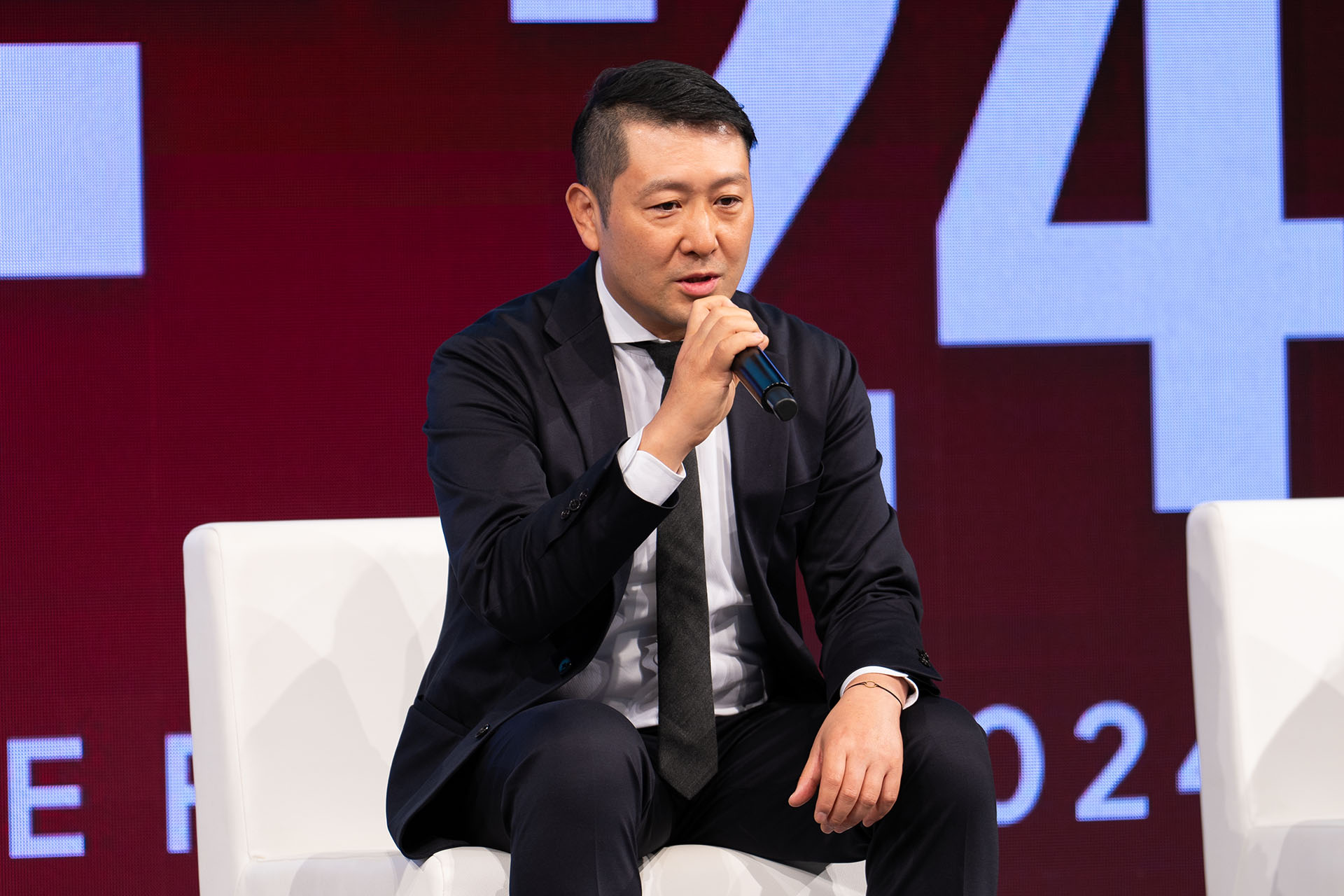Model EDGE: An Entirely New Co-Creation Style Explained by the Two Leaders in Startup Collaboration
Welcoming guests from Mitsui Fudosan and Mitsubishi Electric, a panel discussion on open innovation was held at Global Brain’s annual conference. Panelists discussed how they embarked on business collaboration, and Model EDGE, the secret to success.

Written by the Universe Editorial Team
In December 2024, the independent venture capital firm Global Brain (GB) held its annual conference, the Global Brain Alliance Forum 2024 (GBAF 2024).
Among the sessions held during the day, a panel discussion on business collaboration between startups and the CVC funds of large corporations attracted much attention.
In this session titled “Model EDGE: Driving True Success in Startup-Enterprise Collaborations,” two examples of open innovation were discussed, one between Mitsubishi Electric Corporation (Mitsubishi Electric) and FTV Labs Pte. Ltd. (FTV Labs), and another between Mitsui Fudosan Co., Ltd. (Mitsui Fudosan) and SUPER STUDIO Inc. (SUPER STUDIO).
The panelists were as follows.
-
Takuro Shimizu, Investment Manager, Business Development Group, Open Innovation Department, Innovation Promoting Division, Mitsui Fudosan
-
Tsuyoshi Hidaka, Senior Manager, Business Innovation & Strategy Division, Mitsubishi Electric (Note: Position at the time)
-
Kosuke Hayashi, Representative Director and CEO of SUPER STUDIO
-
Ying Jian Ng, Global Brain Corporation
-
Masaya Kawakami, Global Brain Corporation
-
Moderator: Shohei Hayashi, Global Brain Corporation (GB Hayashi)
This article is a report on the panel discussion.
Mitsubishi Electric’s goal to achieve global digital transformation in business
GB Hayashi: First, I would like to ask about Mitsubishi Electric’s collaboration with FTV Labs. What kind of business does this startup do?
Ying Jian: FTV Labs is a Singapore-based startup that offers KEGMIL, an application designed to streamline maintenance and servicing of manufacturing equipment. This product allows companies to systematize and accumulate internal knowledge, such as diagnostic methods for equipment malfunctions and repair procedures that were traditionally handled as a craftsman’s skill.
GB Hayashi: What led to the partnership between Mitsubishi Electric and FTV Labs, and what outcomes has it produced?
Hidaka: Within the Mitsubishi Electric Group, there is a company called Mitsubishi Electric Building Solutions. Its elevator and escalator segment is one of the group’s most important global businesses. For some time, it has been a significant challenge to globally streamline the maintenance and servicing of elevators and escalators.
To address this, we invested in FTV Labs, given their strong synergy, and advanced our collaboration. As a result, we successfully streamlined the process of dispatching maintenance personnel, which previously relied on phone calls, emails, and manual processes, in multiple countries. This allowed us to globally achieve digital transformation in business.

Ying Jian: For FTV Labs, this collaboration significantly boosted its capabilities in two key areas.
Firstly, FTV Labs successfully developed functionalities required by large corporations. Before this collaboration, FTV Labs operated primarily for small and medium-sized businesses in Singapore. However, driven by feedback from Mitsubishi Electric, FTV Labs has successfully developed modules and middleware that can integrate with Enterprise Resources Planning (ERP) and Customer Relationship Management (CRM) systems used by large corporations.
Secondly, FTV Labs was able to begin expanding its business into neighboring countries. After the decision to implement KEGMIL at Mitsubishi Electric Building Solutions’ Singapore office, there are now plans for rollout to neighboring countries such as Thailand, the Philippines, Indonesia, and Vietnam. Furthermore, the fact that Mitsubishi Electric is using FV Labs’ solution has enhanced its credibility, which has led to securing deals with other major large corporations in Southeast Asia.
The path leading up to the crossboarder collaboration
GB Hayashi: Mitsubishi Electric invested in FTV Labs in 2022, as the co-lead investor with a Singaporean VC, then made an investment about a year later, this time as the sole lead investor. I imagine you went through numerous PoCs during that time. Could you tell us about the challenges you faced and how you overcame them before achieving those results?
Hidaka: We were confident that FTV Labs’ solution was a good fit for our goal of streamlining elevator and escalator maintenance work, so we made the initial investment after various analyses.
Following that, our CVC team developed a strategy to standardize our field service management using FTV Labs’ solution. After demonstrating cost reduction benefits at various offices, including Singapore, the Philippines, and Taiwan, the CVC team spearheaded the initial PoC.
From there, we continued the PoC, involving the business divisions responsible for elevator and escalator maintenance and servicing and local sales companies in Singapore. Since the PoC results were favorable, we invested in FTV Labs as the sole lead investor in 2023 to deepen our strategic collaboration.
A particularly significant challenge in this endeavor was the ERP system integration. Mitsubishi Electric Building Solutions uses different ERP systems at each of its Asian offices, so we needed to meticulously verify whether FTV Labs’ solution would truly align with our systems. GB also provided valuable insights and worked together with us throughout this verification process.

GB Hayashi: Many CVCs struggle with getting business divisions on board, but how was it for Mitsubishi Electric?
Hidaka: Our CVC team did not just invest; we actively led the PoC before transitioning it to the relevant business divisions. During this handover, we engaged in extensive discussions with the Singapore business division, repeatedly emphasizing the importance of the collaboration and providing support with the PoC findings to ensure a smoother integration.
GB Hayashi: Could FTV Labs elaborate on the difficulties encountered during this collaboration?
Ying Jian: As FTV Labs had only dealt with SMEs before, it completely lacked expertise in engaging with large corporations. They have numerous related departments and stakeholders, each with different concerns. FTV Labs’ actual challenges were unclear, leading to confusion.
That was where GB stepped in. We first helped verbalize and inventory the customer’s challenges. We then prioritized these issues and identified how FTV Labs could specifically address them. GB also supported FTV Labs in customer proposals, project promotion, contract finalization, team design, and schedule planning. I believe FTV Labs has now grown to the point where they can secure orders from large corporations on its own.
Mitsui Fudosan’s challenges with e-commerce
GB Hayashi: Next, let’s look at the collaboration between Mitsui Fudosan and SUPER STUDIO. First of all, could you give us an overview of SUPER STUDIO and the challenges Mitsui Fudosan was facing?
Hayashi: SUPER STUDIO is a startup that develops and provides ecforce (website only in Japanese), an integrated commerce platform. Beyond system development, we also plan and operate our own D2C brands. A key feature of our service is that we can offer essential value and drive customers’ business growth by giving them the expertise and successful cases gained from operating our own D2C brands and by providing feedback on system issues to ecforce development.
While we originally had extensive expertise in e-commerce operations and primarily supported e-commerce and D2C brands, in recent years, we have been strengthening our support for digital transformation in commerce centered on online and offline data utilization—a challenge many commerce operators face—, leading to an increase in our product adoption by enterprises.
Most recently, we released ecforce cdp, which enables the creation of a customer data platform for both e-commerce and physical stores. This allows for an end-to-end environment for integrated management, analysis, and utilization of online and offline customer data. We achieve this by integrating customer reservation data and online/offline purchase data into the Customer Data Platform (CDP), visualizing it with the BI tool ecforce bi, and then linking it to the MA tool ecforce ma for CRM. Furthermore, based on insights from operating our own D2C brands, we have also started offering ecforce consulting, a partnership-based business support service. This service covers everything from developing business strategies tailored to the customer’s business phase to supporting the implementation of data solutions like the aforementioned CDP, BI, and MA, and providing consistent support from digital channel sales to data utilization.

Shimizu: At Mitsui Fudosan, our core business has traditionally revolved around offline commercial facilities like LaLaport. However, a few years ago, we also launched our own e-commerce site called &mall, but this site did not quite take off as we had hoped and we were trying to figure things out.
That is why we thought it would be best to collaborate with an e-commerce expert like SUPER STUDIO to effectively merge Mitsui Fudosan’s offline assets and know-how with the e-commerce site. That is how we began discussions for this collaboration.
Hayashi: From the beginning of our collaboration, a key point for us was how to attract Mitsui Fudosan’s offline customers to the e-commerce site and how to effectively utilize customer data gathered from in-store interactions at other commercial facilities.
So, we decided to explore PoC proposals with the idea that our services could contribute not only to data acquisition on the e-commerce site but also to the systems used in commercial facilities.
We repeatedly discussed with Mitsui Fudosan and explored how to offer innovative measures that other developers could not and how to create a system that would boost sales for brands and manufacturers housed in Mitsui Fudosan’s properties.
As a result, we opened THE [ ] STORE (website only in Japanese), a next-generation store at RAYARD MIYASHITA PARK as an OMO solution that supports e-commerce brands’ business growth and combines the real and digital worlds, together with Mitsui Fudosan. Mitsui Fudosan is running several joint businesses, for example, developing a platform that comprehensively supports e-commerce brands’ growth (news release only in Japanese) working together with other startups as well.
GB Hayashi: Did this business collaboration also bring positive effects to SUPER STUDIO’s business?
Hayashi: Yes, I feel that the range of proposals we can offer to customers has definitely expanded.
Brands that have achieved a certain level of sales in e-commerce often consider expanding offline. On the other hand, brands that are successful with physical stores frequently explore e-commerce. When we face these customer needs, it has been a powerful advantage for us to have a track record of working with Mitsui Fudosan in this way and have a structure in place.

How both companies fostered trust, even amidst unexpected team rotations
GB Hayashi: I would also like to ask Mitsui Fudosan and SUPER STUDIO about any challenges or hurdles you faced during the collaboration.
Shimizu: The biggest crisis in this initiative was probably when I became the person in charge (laughs). Actually, I took over the person responsible for the collaboration with SUPER STUDIO in April 2024; before that, another member was handling it. The person who had worked with SUPER STUDIO for about two years had left, and we had to build the relationship from scratch.
In this situation, GB’s Kawakami-san and the Value Up Team (a dedicated team that supports the business of portfolio startups) were incredibly supportive. They would give us detailed wrap-ups after every meeting and even arranged opportunities for me to dine with CEO Hayashi.
Also, as we are a large corporation, we have many stakeholders. Therefore, a crucial point in driving the collaboration was how and when to introduce SUPER STUDIO to which of our internal business units. I believe we were able to overcome the internal coordination challenges precisely because we could consult with GB.
The meeting minutes from our sessions with the Value Up Team are very detailed, which were incredibly helpful. All past interactions between SUPER STUDIO and Mitsui Fudosan are recorded, so even coming in later, I could quickly understand the background of the collaboration. Thanks to this detailed support, our collaboration with SUPER STUDIO took shape.

Hayashi: I also feel the significant presence of GB. One day, GB accompanied us on a sales meeting with another company, which resulted in a great success. They always provide support in many different ways.
Furthermore, we were also very grateful for Shimizu-san’s approach. He consistently worked alongside us to drive the collaboration forward. I strongly felt this in our daily conversations, and I believe his stance was a crucial factor in enabling seamless collaboration.
GB Hayashi: Thank you. As Kawakami-san supported both companies, I would like to hear what you were mindful of in driving the collaboration forward.
Kawakami: As Shimizu-san mentioned, the relationship between a large corporation and a startup is something that GB is keen to nurture. Large corporations and startups sometimes have different approaches to business and differing expectations, and I believe that how they can successfully reach a consensus determines the success or failure of open innovation.
What becomes important here is how to create an environment where each company can speak openly and honestly. From my position as a bridge between both companies, I strived to create opportunities for relationship building also in informal settings.
Another thing which was mentioned earlier is that large corporations have job rotations and the person engaging with a startup may change midway through the collaboration initiative. Instead of letting the relationship break off at that point, it is also critical to pave the way so that new people can quickly settle in when they join.
In supporting CVCs, it is certainly important to analyze startups from a VC’s perspective. Alongside that, creating an environment that fosters open innovation is also something GB consciously focuses on.
Three principles for successful open innovation
GB Hayashi: There is a common thread in the startup collaborations that both Mitsubishi Electric and Mitsui Fudosan have discussed so far: they are both based on a framework called Model EDGE. From here, I would like to delve into this Model EDGE that GB is actively working on.
EDGE stands for Equity Driven Growth Ecosystem. It is a term that represents the concept of startups, large corporations, and VCs collaborating to accelerate open innovation.

There are three points to note in carrying out Model EDGE.
The first point is that VCs provide assurance for continuity and development of business collaboration with startups from an investment view.
As a VC, it is essential to thoroughly analyze the startups as large corporations’ potential open innovation partners from an investment perspective. This is our fundamental responsibility.
The second point is to have startups and large corporations commit to and prioritize the collaboration initiatives by lead-investing.
Mitsubishi Electric also mentioned that their CVC team took strong initiative during the PoC launch. Similarly, with SUPER STUDIO, despite already being a late-stage company, their management team, including CEO Hayashi, showed strong commitment to the collaboration with Mitsui Fudosan. Both examples have in common that these initiatives were driven with high priority within each company.
If a startup’s management team is not involved in the collaboration, or if it has low priority within the large corporation, the initiative tends to stall. To enhance both parties’ commitment, it is crucial to effectively involve each company’s resources by leading the investment.
Of course, minor investments are not necessarily bad. If the goal is simply to utilize an already-developed startup product or add it to your investment portfolio, then there is no issue. However, as in today’s examples, if you are collaborating with a startup to create something new or undertake large-scale, crossborder challenges, strengthening commitment through lead investment is the secret to success.
The third point is that VCs set goals and manage projects as partners with deep understanding of the business strategies and organizations of both sides.
As Kawakami mentioned, we believe the essence of open innovation lies in the VC acting as an intermediary to facilitate communication between large corporations and startups, clarifying both parties’ strategic priorities, and setting short-term and medium-to-long-term goals.
In open innovation, it is not uncommon for initiatives to run out of steam after setting unrealistically high initial goals. The key is to collaborate in a way that is valuable to both the startup, which seeks short-term results, and the large corporation, which aims for medium-to-long-term outcomes. First, establish mutual trust through quick wins, and then work together to achieve larger, medium-to-long-term goals. It is crucial to design programs that consciously follow these steps.

Finally, based on the Model EDGE approach, I would like to ask you once again what you think are the keys to successful open innovation.
Hidaka: In the case of Mitsubishi Electric, the stakeholders included FTV Labs, our CVC team, the business division that handles elevators, and a sales company in Singapore that performs maintenance work. Aligning the expectations of these four parties was a challenging project due to differences in business practices and culture. However, GB, led by Ying Jian-san, acted as a liaison to adjust expectations, which I believe was a major factor in the success of the project.
Hayashi: We are already working on a new project with Mitsui Fudosan in addition to the initiative introduced to you today. Of course, the relationship with our lead investor is important, but I also believe that we have been able to get this far thanks to the support of people like Shimizu-san and everyone at GB. Going forward, we will continue to take responsibility and launch services that deliver solid results.
Shimizu: When proposing collaboration with startups within large corporations, you may often hear responses such as, “Why not just outsource the work instead of investing?” However, I believe that the equity-driven approach advocated by Model EDGE is precisely the mindset that is needed. By investing and becoming a shareholder, we can truly “be in the same boat” and grow together, which will undoubtedly lead to new opportunities and achievements.
I personally refer to large corporations and startups associated with GB as the “Global Brain family.” I think it would be very interesting to work with them to invest in Japan’s startup ecosystem and build a better Japan. As a partner supporting the startup ecosystem, I truly hope GB will continue to work alongside us in the future as well.